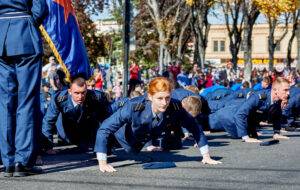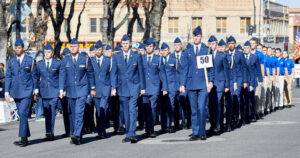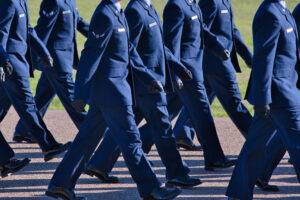
The appearance of U.S. Department of Defense (DoD) visual information does not imply or constitute DoD endorsement.
You likely already know that going into the U.S. Armed forces is a great way to get Uncle Sam to pay for a college degree. The GI Bill® is legendary for putting generations of veterans through school as a reward for their service. And every branch has ways to support service members pursuing a degree while still on active duty, or even while in the reserves.
But you may not have known that there are a few select ways you can actually get the government benefits for getting a degree before you enter the service.
These programs put together a great package that lets you serve your country with your advanced college education, and then benefit from the experience both during and after your service.
In other cases, you may enlist under programs that offer specific educational benefits during or after your service—but your eligibility depends on your initial enlistment contract.
Either way, if you’re thinking about how to combine your call to service with great educational benefits, it pays to think about going to college before you sign up for military service.
Explore Your Benefits Options
Why the American Military Might Want To Pay For Your Education Before You Enlist
Many of the fields where the military most needs expertise right now are the same ones that are hot career prospects in the civilian world:
- Law
- Computer science and information technology
- Psychology
- Medicine
Those are hugely important roles in the modern military. You might find yourself running a high-tech Patriot anti-missile battery, protecting thousands of troops and civilians under dangerous skies. Or developing new counter-insurgency campaigns to undermine the population support for a terrorist group, winning battles without ever firing a shot.
 But with the same skills, you could also be a hotshot game developer, doctor, lawyer, or psychological counselor in the civilian world.
But with the same skills, you could also be a hotshot game developer, doctor, lawyer, or psychological counselor in the civilian world.
It’s a hard call for anyone who is just graduating with those degrees to make the choice to put on a 50-pound ruck and go humping through the desert for days on end instead of settling into a nice six-figure office job right away.
So, Uncle Sam understands that maybe a little incentive to join would be nice. Getting a college education today is an expensive proposition. According to the National Center for Education Statistics, the costs of getting a bachelor’s degree in 2020 were 13 percent higher than they were a decade before. And the cost just seems to be going up.
For some folks, having the military pick up the tab in return for a certain commitment to service looks like a good bargain. And it’s a good deal for the military, as well. They get a candidate qualified for exactly the kind of jobs they need to fill, obligating that candidate to six or more years in that position.
Pre-service military college benefit options exist for both officers and some enlisted ranks.
Joining the Military After College Is Usually Mandatory for Officers
Any veteran or service member in any branch, from any pay grade, will tell you: it pays to be an officer.
We don’t just mean in terms of dollars, although that’s true, too. Officers get more pay, better quarters, more flexibility, more training, and more interesting tasks. They have far better prospects once they get out of the military, too. According to 2019 survey data from Pew Research, nearly 80 percent of commissioned officers rate their military service as being useful in getting the training they needed for civilian work. That’s the highest rate of any rank group.
While a lot of people join the military to get a college education paid for through the GI Bill®, for officers it works backward: you need to get that degree before you join up.
Earning a degree before commissioning is a high bar to clear. It’s also a tough choice, considering that, as good as officers have it versus enlisted ranks, those college degrees could almost always lead to even more lucrative positions in the civilian world. Choosing to join the military, even by being commissioned, is the path of dedication and service, not wealth and luxury.
According to 2021 data from the Congressional Research Service, about 18 percent of the armed forces are in the officer corps. That’s 217,190 jobs, not counting slightly fewer than 19,000 warrant officers.
The Military Values the Critical-Thinking Skills You Develop with a College Degree
 If you ask around (and not just among enlisted personnel, whose opinions may be slightly biased in this matter!), military scientists will tell you the American military is pretty top heavy for a well-oiled military machine. Too many people giving orders and not enough people following them doesn’t get the job done.
If you ask around (and not just among enlisted personnel, whose opinions may be slightly biased in this matter!), military scientists will tell you the American military is pretty top heavy for a well-oiled military machine. Too many people giving orders and not enough people following them doesn’t get the job done.
But there’s one big reason behind the rank inflation you find in the U.S. military today: technology.
As the most high-tech military force on the planet, the American military just needs a higher proportion of well-educated members. Complex systems demand an advanced education. And a bachelor’s degree is entry-level preparation for mastering today’s war-fighting technologies.
It’s not just because these degrees give you detailed technical skills. The military is just as happy to take you if you have a liberal arts degree as one in computer science.
That’s because the big thing they care about is problem-solving. Adaptability. Critical-thinking under pressure.
And these are all qualities honed in the mind of a college graduate. You are, by earning that degree, making yourself a trainable, adaptable individual, who can learn on the fly and rapidly adjust to combat scenarios.
Almost all of those 217,000-plus officers had to go out and get a college degree. But not all of them had to pay for it! The good news is that there are paths that offer incentives for earning a bachelor’s on your way to becoming an officer.
Becoming a Military Officer by Graduating From a Service Academy
The most prestigious, elite path to becoming an officer is through one of the four dedicated American military service academies:
- United States Military Academy - Army, West Point, New York
- United States Air Force Academy - Air Force and Space Force, Colorado Springs, Colorado
- United States Naval Academy - Navy and Marine Corps, Annapolis, Maryland
- United State Coast Guard Academy - Coast Guard, New London, Connecticut
 These are world-renowned colleges. Just dropping the name West Point in casual conversation carries a freight-load of hard-earned reputation. The vaunted long gray line stretches back to U.S. Grant and Robert E. Lee and includes Medal of Honor winners, astronauts, and U.S. presidents.
These are world-renowned colleges. Just dropping the name West Point in casual conversation carries a freight-load of hard-earned reputation. The vaunted long gray line stretches back to U.S. Grant and Robert E. Lee and includes Medal of Honor winners, astronauts, and U.S. presidents.
Alongside the training and discipline required to become an outstanding junior officer and leader, however, you also study the same kind of college coursework offered in any civilian school. West Point alone offers more than 60 majors, ranging from nuclear engineering to sociology.
Of course, if you go the service academy route, you get paid to get the degree and you earn it along with your commission. And you get a big, flashy ring to show off, too.
This all comes free of charge. Tuition, fees, books and supplies, room and board—it’s all part of the package. And most cadets receive a basic living stipend during their training as well.
Service Academy Admissions Standards Are High
Getting into a service academy is a tough business, though. These are the only universities in the country where admissions requirement are written into federal law! Something as small as a tattoo in the wrong location is a disqualifier.
Even if you check all the boxes, though, getting in isn’t easy. There are slightly more than 1,200 admission to the Corps of Cadets at West Point each year, for example… but more than 12,000 people apply for those slots.
Each applicant must be nominated by a Congressperson or the Vice President of the United States, each of whom only have 5 slots to hand out each year. And it goes without saying that your scholastic and extracurricular background has to shine. You’re up against valedictorians and star high school athletes, Type-A personalities all the way. Come ready to compete if you want to get in.
The Coast Guard Academy is an exception to the rule requiring a Congressional nomination for admission—any U.S. citizen can apply, although standards are just as stringent as the other services.
The Service Academy Experience Goes Beyond University Expectations
 Although you get a bachelor’s of science in your chosen field, the experience is far from a normal American university student. Your summers are spent out on field exercises or at sea, learning the stock in trade of your service. You will have to memorize vast amounts of information and recite it back on demand just to test your recall and commitment. Guard duty will be assigned. And if you slip, expect a healthy dose of punishment tours, marching back and forth until your lesson is learned.
Although you get a bachelor’s of science in your chosen field, the experience is far from a normal American university student. Your summers are spent out on field exercises or at sea, learning the stock in trade of your service. You will have to memorize vast amounts of information and recite it back on demand just to test your recall and commitment. Guard duty will be assigned. And if you slip, expect a healthy dose of punishment tours, marching back and forth until your lesson is learned.
The strict discipline can be an asset to your education. You have constant support available from peers, instructors, and college resources. You’re all part of a unit. Your success is their success.
In return for all this support and a free first-class education in the field of your choice, you are signing up for a minimum of five years of service in most cases. But, as you’ll see as you browse our in-service military education opportunities guide, those years can offer even more advanced education options.
Did you know that you may be able to become commissioned in a service other than the one affiliated with the academy you join? Each year, a handful of graduates from the service academies switch services by special application for inter-service transfer.
Getting an Education to Become a Military Officer By Joining the Reserve Officer Training Corps
 The Reserve Officer Training Corps (ROTC) is the most common way that officers are trained and commissioned into the American military. Despite the word Reserve in the title, slightly over half of all active duty officers are commissioned through ROTC.
The Reserve Officer Training Corps (ROTC) is the most common way that officers are trained and commissioned into the American military. Despite the word Reserve in the title, slightly over half of all active duty officers are commissioned through ROTC.
ROTC programs are located on more than 1,700 campuses nationwide. They are operated independently by the Army, Air Force, and Navy. Marine and Space Force officers are trained by Navy and Air Force ROTC programs respectively.
The Coast Guard has no ROTC program. Instead, their branch-specific College Student Pre-Commissioning Initiative offers scholarship money for college sophomores leading to commissioning as an ensign after graduation.
The benefits side of ROTC is harder to pin down than with service academies. While ROTC can come with scholarships that cover up to 100 percent of your tuition, as well as offering personal stipends, book and supply allowances, and occasionally room and board, that’s not true for everyone.
Instead, ROTC offers a variety of different scholarship to qualified students. These may offer a full ride, but may also only offer partial tuition assistance and less benefits overall.
In general, officers commissioned through ROTC have only four-year service commitments.
There Are Many Paths to ROTC Admissions
In part, the reason that ROTC has so many possible different benefit levels is that it covers many more kinds of applicants than service academies. You might come in to ROTC as:
- A true college freshman, applying simultaneously with your college admission
- A high-school senior in a delayed entry program
- A current active-duty enlisted service member, through special enlisted commissioning programs
- A current college student already part way through earning your degree
 ROTC is also unique in that you can typically enroll in introductory military coursework without making any service commitment. It’s a perfect try-before-you-buy opportunity to get a taste of military life without devoting years of service.
ROTC is also unique in that you can typically enroll in introductory military coursework without making any service commitment. It’s a perfect try-before-you-buy opportunity to get a taste of military life without devoting years of service.
In order to be accepted into ROTC and to receive any scholarship funding, however, you also have to meet all the regular military officer recruitment standards. These include:
- Be a U.S. citizen with a high-school diploma or GED
- Meet age standards for your branch
- Pass branch physical fitness standards
- Meet minimum standards for ACT or SAT scores
And you’ll have to maintain a college GPA of at least 2.5 or risk being dropped from the program, and your funding.
ROTC Mirrors The Typical Civilian University Experience With a Few Modifications
 These programs don’t integrate military and college studies quite as closely as service academies. You’ll be in courses taught by civilian instructors, with regular civilian students, with the same day-to-day experience as any of them. There are no restrictions on the major you choose.
These programs don’t integrate military and college studies quite as closely as service academies. You’ll be in courses taught by civilian instructors, with regular civilian students, with the same day-to-day experience as any of them. There are no restrictions on the major you choose.
ROTC allows you to simultaneously prepare for a military officer position, and the permanent civilian career you will eventually go into.
On the other hand, your summers are no longer your own. Although you will take some coursework in military theory as part of your regular course load, becoming an officer is more than just analytics. You’ll also get your hands dirty in the field with training and exercises to develop leadership skills in real-world combat scenarios.
Military Colleges: Reserve Officer Training That Feels Like a Service Academy
 There is a kind of halfway option between civilian university ROTC programs and the national service academies. These are private military colleges that implement the ROTC program, but independently organize and discipline their entire student body in the same manner as the academies.
There is a kind of halfway option between civilian university ROTC programs and the national service academies. These are private military colleges that implement the ROTC program, but independently organize and discipline their entire student body in the same manner as the academies.
Only the Army ROTC officially recognizes these programs. It divides them into Senior, or Major, and Junior military colleges.
Junior military colleges offer two-year associate’s degrees through the Army’s Early Commissioning Program, which allows you to become a second lieutenant while continuing to pursue your bachelor’s degree on active duty.
Senior Military Colleges require all students accepted to participate in ROTC training. Only those who actually receive ROTC scholarships are required to join the military on graduation.
Some SMCs are devoted to military training, while others exist as part of larger universities with civilian students. Senior Military Colleges in the United States today are:
- Texas A&M University Corps of Cadets
- Norwich University
- Virginia Military Institute
- The Citadel
- Virginia Tech Corps of Cadets
- University of North Georgia
- Virginia Women’s Institute for Leadership
There are some differences between Air Force, Army, and Navy ROTC. For details, you can check out our Reserve Officer Training Corps Guide.
Military Education Benefits Available for Direct Commission Officers
Some specialties required in the military require such intensive pre-commissioning training, or have such focused roles in the service, that they don’t always fit well with the typical training cycle for officers. Consider the unit padre, for example, or the battalion surgeon. Putting those folks through OCS is a waste of time for both them and the drill instructors—they are getting the expertise the unit really needs from other sources.
If you are in one of those select, high-demand professions, then you may be able to enter as a direct commission officer.
What Is a Direct Commission Officer?
DCO billets are those that require specialized expertise with a limited requirement for traditional tactical and strategic military training. Think lawyers, weather forecasters, chaplains, and doctors.
These are all roles that deserve the respect and pay that an officer billet brings, but don’t need the same formal military training that line officers need. In fact, the military fully recognizes that it’s a full-time commitment just to get credentialed in those specialized fields.
So DCO programs allow people with those qualifications to join directly, without a lot of the traditional requirements of officer slots. In a few cases, you can even find DCO programs that will help pay for your professional training along the way.
Becoming a Military Officer Through the Health Professions Scholarship Program
 The Health Professions Scholarship Program offers one of the most comprehensive scholarships in American healthcare education today. As a joint offering of the Army, Navy, and Air Force, you can get a grant to complete your medical education and enter the force of your choice directly.
The Health Professions Scholarship Program offers one of the most comprehensive scholarships in American healthcare education today. As a joint offering of the Army, Navy, and Air Force, you can get a grant to complete your medical education and enter the force of your choice directly.
HPSP covers your medical school tuition in full, as well as offering:
- Reimbursements for required books, equipment, and supplies
- A monthly living stipend of $2,400
The program only accepts about 300 students per year.
Applications to the Health Professions Scholarship Program Are Highly Competitive
Application for HPSP happens at the same time you are applying for med school. You have to apply separately to each service that interests you, even though it’s the same program.
Naturally, you have to actually get into med school for your application to be accepted. That means already holding a baccalaureate degree and meeting all the regular med school admissions requirements, including scoring high the formidable MCAT test. And you have to meet all other general requirements to become an officer in the service.
ROTC and other active duty military students are allowed to apply to HPSP. You have to follow different procedures, however, requesting a contingent release of your other obligations in the event you are accepted.
Experiences in the Health Professions Scholarship Program Offer a Standard Medical School Education
 HPSP is a bit like ROTC in that you are enrolled in a civilian medical school and have the same classes and experiences as your civilian classmates. You have no express military obligations while you are getting through school, leaving you free to concentrate on your medical education.
HPSP is a bit like ROTC in that you are enrolled in a civilian medical school and have the same classes and experiences as your civilian classmates. You have no express military obligations while you are getting through school, leaving you free to concentrate on your medical education.
Also like ROTC, however, your summers are given over to the kind of specialized training it takes to make an officer. On top of officer training, a 45 day training period for each year of your scholarship will put you into clinical rotations at military hospitals or research assignments. You will receive pay and benefits during these periods equivalent to the O-1 grade in your service.
After obtaining your medical license, you may go on to the typical post-graduate residency training. Or you may be able to enter active service at that point as a general medical officer, getting your hands dirty and taking on real medical responsibilities almost immediately.
Can Officer Candidate School Help Pay for a College Education?
 OCS, or Officer Candidate School (OTS, Officer Training School, in the Air Forces… zoomies gonna zoom their own way) is a more straightforward way of getting into active duty service as a commissioned officer.
OCS, or Officer Candidate School (OTS, Officer Training School, in the Air Forces… zoomies gonna zoom their own way) is a more straightforward way of getting into active duty service as a commissioned officer.
But OCS programs are typically aimed at individuals who have already earned a college degree. They do not offer additional funding or incentives for you to get a degree if you haven’t already.
Uniformed Services University of Health Sciences Offers a Medical School Education Directly From the Military
 If you’re looking for a military medical career that puts you in a martial mindset from day one, then the Uniformed Services University might be your ticket.
If you’re looking for a military medical career that puts you in a martial mindset from day one, then the Uniformed Services University might be your ticket.
This is a medical school located in Bethesda, Maryland, that is actually run by the military itself. It’s accredited just like any other medical school and jointly administered by the Army, Navy, Air Force, and Public Health Service.
If you are accepted into USU, you become a commissioned officer upon entry, with all the benefits and pay those positions accrue. And because you are a military officer attending a military school, there’s no charge at all for your education… just your commitment for at least seven years service in the branch you were accepted into.
The USU Application Process Uses Standard Medical School Procedures
Application to USU is made through the same American Medical College Application Service that governs most med school admissions in the United States. The process is very similar to other med schools, with interviews, essays, and a lot of attention paid to your MCAT and undergraduate GPA scores.
If you are accepted, you’ll be asked to rank which services you would like to join. And you’ll have to meet the standards for commissioned officers of those services, of course.
The USU School Experience Is Unlike Other Medical Schools
The first 18 months of USU education is very similar to any first and second year medical school. With a combination of military and civilian instructors, you’ll spend time learning the basic elements of anatomy, pharmacology, and pathophysiology.
But you’ll be in the military, studying in uniform and subject to military regulations. And in addition to the basic core coursework, you’ll participate in field training exercises and learn principles of military medicine.
After your first 18 months, your experience will take another big turn. You’ll be sent out on a year of rotations through civilian hospitals, military medical postings, and VA hospital assignments. You’ll develop an appreciation of the various kinds of positions and specialties you might apply for.
But you also have a limited amount of personal choice—ultimately, your next rotations will be where the branch determines it needs expertise.
Benefits of Joining the Military After College for Enlisted Ranks
 In a modern high-tech military like the American armed forces, it can’t just be the officers who bring advanced knowledge and critical thinking skills to the fight. There are plenty of enlisted jobs that take just as much, or maybe even more, brains and know-how.
In a modern high-tech military like the American armed forces, it can’t just be the officers who bring advanced knowledge and critical thinking skills to the fight. There are plenty of enlisted jobs that take just as much, or maybe even more, brains and know-how.
That’s why you’ll also find a few pre-enlistment incentive programs to get a college degree for certain specialties in the enlisted ranks, too. If you want to be a aviation electronics technician, or a information and communications technician, you can just about write your own ticket.
You’ll even find high demand for combat imagery and social media operations specialists—in fact, it’s one of the Marine Corps’ 2022 Enlistment Incentive Program categories.
The best military jobs for college graduates are always shifting based on demand. They can vary by year or even by branch. You’ll have to talk to your recruiter to see what the current needs are.
These programs aren’t usually as generous in terms of direct college training as the officer-oriented pre-service programs. But on the other hand, there are a lot more slots open in the enlisted ranks.
Most pre-enlistment benefits are only actually pre-enlistment guarantees of some sort. You won’t actually receive them before you are enlisted. But in order to get them while you are in the service, you have to make sure that they are specified in your enlistment contract.
The National Call to Service Program Offers Benefits for Joining Up With a College Degree
One of the big obstacles to many people when it comes to joining the military is the lengthy commitment. Not everyone wants to put in three or four years of service—six to qualify for some of the better benefits.
DoD understands the issue. The National Call To Service program, currently offered by all branches, rewards enlistees who agree to a specific, in-need MOS with a limited two-year obligation and a selection of other possible incentives.
Included in those are three different possible educational benefits:
- Repayment of qualifying student loans through the active duty SLRP program
- Montgomery GI Bill® eligibility for one year despite not otherwise hitting the minimum service requirement
- Montgomery GI Bill® eligibility for the full 36 months at a 50 percent rate
Guaranteed Training Enlistment Options Can Ensure You Get College Credits for Specialty Training
 Every branch recognizes that the right recruiting incentives can sweeten the deal for potential enlistees who are on the fence about joining up. And each branch offers a variety of different programs to give you the motivation you need, from buddy deals that let you stick with your best friend through training and initial stations to plain old cash bonuses.
Every branch recognizes that the right recruiting incentives can sweeten the deal for potential enlistees who are on the fence about joining up. And each branch offers a variety of different programs to give you the motivation you need, from buddy deals that let you stick with your best friend through training and initial stations to plain old cash bonuses.
But one way you can leverage your enlistment contract for education is to get a guaranteed training deal before you sign on the dotted line.
These enlistment bonuses promise that you will be given a selected MOS or duty station if you enlist. Although some people use this to get an assignment close to home, or in some easy duty slot, you can also use it to get access to service schools that a particular MOS is required to attend.
In some cases, this could include actual college courses; in others, it can offer highly technical training that you may later be able to use to acquire college credit through testing via the DANTES CLEP program.
Requirements for Guaranteed Training
Acceptance to guaranteed training programs is almost always pinned to your ASVAB scores (Armed Service Vocational Aptitude Battery). The higher your score, the more likely your recruiter is going to bend over backward to get you into the MOS you want.
The Advanced Rank Enlistment Program provides a promotion immediately after Basic Training in return for prior education or experience. This might sound similar to Guaranteed Training. But this program is only a reward for your prior education, and does not offer any in-service path to additional education.
Although the program is called “guaranteed” you have to understand it’s really more like “best effort.” The military can always shuffle the MOS around, or change the training requirements, or sometimes even close the service school you wanted to get into.
The Student Loan Repayment Program Covers Education Expenses You Already Accrued
The Student Loan Repayment Program, or SLRP, is an active duty program that is actually a kind of retroactive pre-service educational benefit. It is a commitment written into your enlistment contract to have the military take over loan payments on current outstanding student loan debt that you are carrying when you enlist.
That “when you enlist” part is very important—you need to make sure you get SLRP terms written into your enlistment contract in order to take advantage of the program. That’s why we’re telling you about this in the pre-enlistment benefits.
It’s not an automatic benefit—instead, it’s a kind of enlistment bonus, and recruiters don’t hand those out like candy. Only certain specializations are eligible. On the plus side, reservists in those specializations can take advantage of SLRP as well as active duty members.
You may be eligible for SLRP repayments even if you have not yet completed your degree program.
Other SLRP qualifications include:
- Only federal student loans, such as the Stafford or Perkins, are eligible
- The loans must not be in default
- You’ll have to commit to a certain commitment for service, usually six years or more
- You must meet a specific ASVAB score, typically 50 or above
- You have to agree to give up any possible Montgomery GI Bill® benefits you might otherwise have qualified for
SLRP Comes With Slightly Different Loan Repayment Benefits Depending on the Armed Services Branch
The benefit pays up to one-third of your outstanding loan principal balance each year. That continues until you bump up to the total lifetime limit. SLRP is capped at the following totals for the different services:
- Army - $65,000
- Navy - $65,000
- Coast Guard - $30,000
Each branch has different terms and specifications for SLRP. In fact, you might end up with different terms from others in your branch just based on your individual contract.
The Air Force and Marines have both offered SLRP in the past but are not offering it in general as of 2022. The Air Force does have a similar program, however, called the Health Professions Loan Repayment Program, which will cover up to $40,000 in repayment only for qualifying enlistees with outstanding medical education debt.
It’s possible to negotiate SLRP into reenlistment contracts as well, although you still have to sign up for a lengthy additional commitment.
There are a couple of gotchas with SLRP that you’ll want to watch out for, however. Although the payments are sent directly to loan servicers, they are still counted as personal income to you. That means you’ll owe taxes on them, just as if they had come in your paycheck.
Also, if you are in the reserves, you’re not allowed to use SLRP and your MGIB-SR benefits at the same time.
Although the benefits of joining the military with a college degree are fewer than what you will find after discharge, if you play your cards right they can all come together for your dream career.
Joining the military after college sets you up to build on your education with real-world experience. Beyond that, it means that your veteran’s education benefits will still be available to use for a graduate degree after discharge. That means you can eventually earn a master’s or even a doctorate with your GI Bill® benefits.





